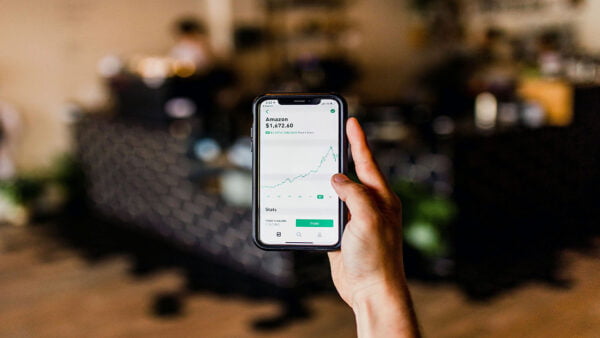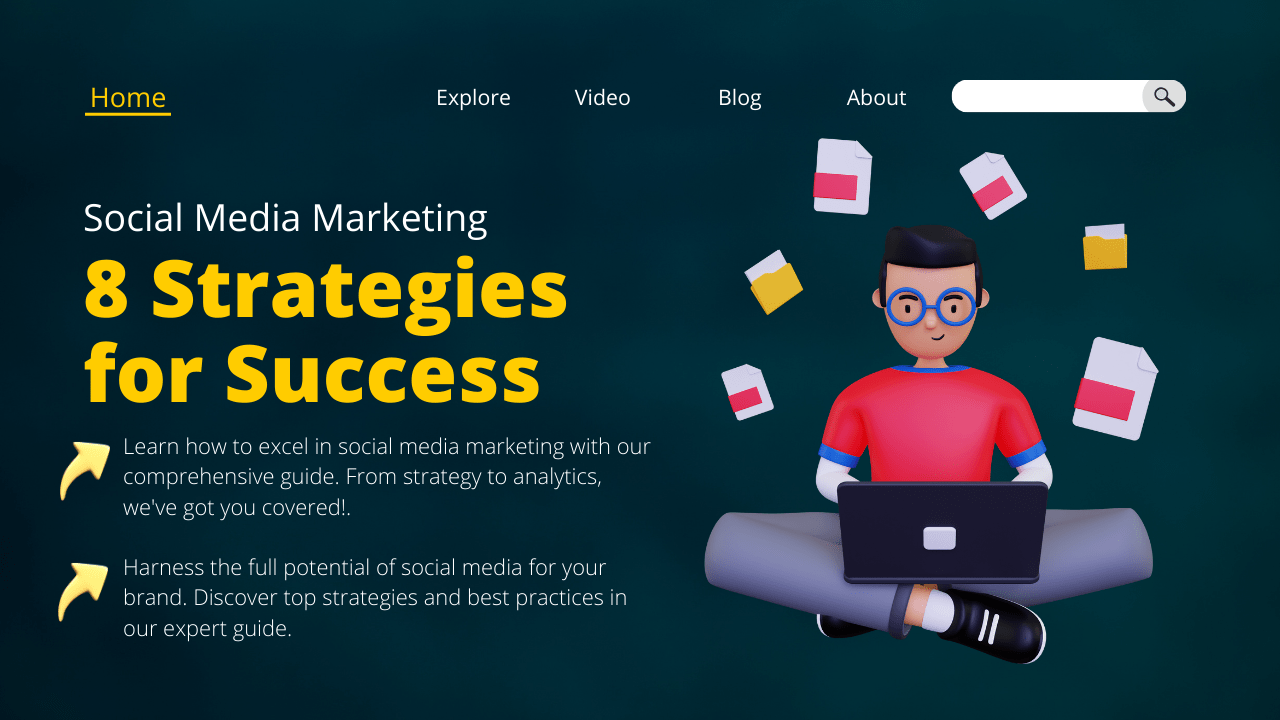Social Media Metrics: 6 Guide to Tracking Success
In the digital age, where social media reigns supreme, keeping a finger on the pulse of your online presence is no longer optional; it’s imperative. In this ever-evolving landscape, where trends shift as quickly as viral cat videos, understanding and harnessing the power of social media metrics is your golden ticket to online success. So, why should you care about these metrics, and how can they be your passport to social media stardom?
The importance of social media metrics
Imagine embarking on a road trip without a map or GPS. Sounds chaotic, right? Well, that’s what managing social media without metrics feels like. Metrics act as your navigational tools in the vast and often convoluted world of social media. They provide you with valuable data, like how many people your posts reach, who’s engaging with your content, and whether your efforts are translating into real-world results. Without these insights, you’re essentially driving blind, and you might end up in a content marketing cul-de-sac.
How tracking metrics can boost your social media strategy
Tracking metrics is not just about patting yourself on the back when you see impressive numbers; it’s about improvement. It’s about understanding what’s working and what’s not. These insights empower you to tweak your strategy, optimize your content, and engage with your audience in ways that genuinely resonate. Whether you’re an influencer looking to grow your followers or a brand striving to increase sales, metrics provide the actionable information you need to make informed decisions.
The challenge of choosing the right metrics
Before we dive headfirst into the world of social media metrics, it’s essential to address a common pitfall: the overwhelming abundance of metrics available. The challenge isn’t just tracking these numbers; it’s determining which metrics align with your goals. Should you focus on engagement metrics like likes, comments, and shares, or are conversion metrics like CTR and sales more critical for your success? We’ll navigate this complex terrain together, helping you decipher the metrics that truly matter to your specific goals.
So, fasten your seatbelts, as we embark on this exciting journey through the world of social media metrics. Whether you’re a seasoned social media guru or just dipping your toes into these waters, this guide will equip you with the knowledge and tools to become a metrics maestro. Prepare to boost your online presence, engage your audience, and drive real-world results, all while enjoying the ride. Let’s set sail on the high seas of social media metrics, where you’re the captain of your digital destiny.

Engagement Metrics
Engagement metrics are like the applause and cheers at a live performance. They tell you how well your audience is connecting with your content, and they are a vital aspect of your social media strategy. In this section, we’ll explore the different facets of engagement metrics, how to interpret them, and ways to boost your performance.
Likes, Comments, and Shares, why matter?
Likes are like the nods of approval from your audience. They indicate that someone appreciated your post enough to give it a virtual thumbs-up. But, their importance goes beyond vanity metrics. They’re a signal to social media algorithms that your content is engaging and worthy of being seen by more people.
Comments, on the other hand, represent an active dialogue with your audience. They’re a sign that your content has sparked a conversation. Engaging with these comments can foster a stronger community around your brand or profile.
Shares are the ultimate endorsement. When someone shares your content, they’re essentially saying, “This is so good that I want my followers to see it too.” This extends your reach and brings more potential fans, followers, and customers into your fold.
How to interpret these metrics
When you see high numbers of likes, comments, and shares, it’s a good indication that your content is resonating with your audience. However, it’s not just about quantity. Quality matters too. If you have high engagement, but it’s from the wrong audience or consists of spammy comments, it may not be as valuable as you’d think.
Real-life example: A viral post’s engagement metrics
Consider the case of a small startup that posted a heartwarming video showcasing their team volunteering at a local animal shelter. The post received a staggering 10,000 likes, 5,000 comments, and 20,000 shares. On the surface, this seems incredible. However, upon closer inspection, it was revealed that the majority of the engagement came from a demographic that had no interest in the startup’s product. While the post went viral, it didn’t translate into real-world results for the company. This example underscores the importance of not just looking at numbers but understanding who your audience is.
Click-Through Rate (CTR)
Definition of CTR
Click-Through Rate (CTR) is a metric that measures how effective your content is at encouraging your audience to take the next step. This “next step” could be clicking a link, visiting your website, or signing up for a newsletter. It’s a valuable metric for evaluating the performance of your posts when the primary goal is to drive traffic.
How to calculate CTR
To calculate CTR, you divide the number of clicks by the number of impressions (times your post was shown). Then, multiply the result by 100 to get the percentage.
CTR (%) = (Clicks / Impressions) x 100
For instance, if your post had 1,000 impressions and 100 clicks, your CTR would be 10%.
The significance of a high CTR
A high CTR indicates that your audience finds your content compelling enough to take action. It’s not just about passive appreciation; it’s about active engagement. A high CTR is often a sign that your content and your call to action (CTA) are aligned and effective.
Improving CTR with compelling content
To boost your CTR, focus on creating compelling content and crafting clear, enticing CTAs. Use actionable language, and make it evident why your audience should click. For example, if you’re sharing a blog post, your CTA could be, “Learn More” or “Read Now.” Experiment with different CTA styles and measure their impact on your CTR. A captivating image or video can also make a difference. Sometimes, it’s the visual that entices the click.
In our journey through social media metrics, engagement metrics are your opening act. They set the tone for the performance, and they are a crucial barometer of how well your content is connecting with your audience. But engagement is just the beginning. We’ll dive deeper into reach, conversion, customer satisfaction, content performance, and competitor analysis metrics in the upcoming sections. So, stay tuned and keep those likes, comments, and shares coming!

Reach Metrics
Imagine you’re throwing a grand party, but to make it a hit, you need people to show up. Reach metrics are the RSVPs to your social media soirée. They tell you how many eyeballs your content is reaching, and understanding them is crucial for expanding your digital footprint. In this section, we’ll unpack the world of reach metrics and explore their significance.
Follower Growth
Tracking the growth of your social media following
One of the first steps to making your social media presence known is building a robust following. This metric tracks the number of new followers you gain over time. Whether you’re an influencer aiming to increase your fan base or a business looking to grow your customer base, follower growth is an essential metric.
Strategies for increasing followers
There’s no secret sauce for gaining followers, but there are strategies that can help. Consistent, high-quality content is key. Engaging with your audience and collaborating with others in your niche can also boost your follower count. Contests, giveaways, and promoting your social profiles on other marketing channels can provide an extra push.
The difference between organic and paid growth
Follower growth can occur organically or through paid means. Organic growth happens when people discover and follow your account without any monetary incentives. Paid growth, on the other hand, involves running targeted advertising campaigns to attract followers. Balancing these approaches depends on your goals and budget.
Case study: A successful follower growth campaign
Let’s take the example of a local bakery that wanted to grow its social media following. They ran an Instagram contest where users had to post a photo with the bakery’s hashtag to enter. The prize? A year’s supply of cupcakes. The contest went viral, and they gained 5,000 new followers in just one month. This creative approach to follower growth not only increased their reach but also their customer base.
Impressions
What impressions represent
Impressions tell you how often your content is displayed on someone’s screen. Each time your post appears in a user’s feed, it counts as an impression. While it might seem similar to reach, impressions can be a much larger number. One person can create multiple impressions by seeing your content more than once.
The correlation between impressions and reach
Impressions and reach are closely related but not identical. Reach is the total number of unique people who see your content, while impressions represent the total number of times your content is displayed. If your content is displayed multiple times to the same person, it contributes to a higher impression count but doesn’t necessarily expand your reach.
Boosting impressions through hashtags and content
Strategically using hashtags can significantly increase your impressions. When you use relevant hashtags, your content becomes discoverable to a broader audience interested in those topics. Additionally, posting content that encourages shares and saves can lead to your content being displayed more often, further increasing your impressions.
A comparison of impressions on different platforms
Impressions can vary significantly between different social media platforms. For instance, Twitter and Instagram may yield higher impression counts due to the fast-paced nature of their feeds, while Facebook might have lower impressions but potentially higher reach. Understanding these platform-specific differences is crucial for crafting a successful social media strategy.
In this guide, you’ve delved into the world of reach metrics. Building your audience and ensuring your content gets in front of their eyes is the first step in your social media journey. But, don’t be too quick to leave the party because next, we’ll explore conversion metrics, which reveal how well you can turn those guests into loyal patrons. Stay with us as we navigate the intriguing world of social media metrics together.

Conversion Metrics
Imagine you’re running a bakery, and your goal is not just to have people admire your cupcakes but to see them walk out the door with a box of your delicious treats. Conversion metrics are like the cash register ringing in your social media strategy. They tell you how effectively your online efforts are translating into real-world actions. In this section, we’ll explore the world of conversion metrics, what they mean, and how to optimize them.
Conversion Rate
Defining conversion rate in social media
The conversion rate is the percentage of people who take a desired action, such as signing up for a newsletter, making a purchase, or filling out a contact form, after interacting with your social media content. It’s a critical metric for understanding how effectively your social media strategy is leading to tangible results.
Calculating conversion rate
To calculate your conversion rate, divide the number of people who completed the desired action (the conversions) by the total number of people who had the opportunity to do so (the total audience). Then, multiply the result by 100 to get the percentage.
Conversion Rate (%) = (Conversions / Total Audience) x 100
For instance, if you had 500 people click on your “Buy Now” button, and 25 of them made a purchase, your conversion rate would be 5%.
The role of strong calls to action (CTAs)
A strong, compelling call to action (CTA) can make a significant difference in your conversion rate. Whether it’s “Shop Now,” “Subscribe Today,” or “Get Started,” a well-crafted CTA guides your audience towards the desired action. The clarity and persuasiveness of your CTA can significantly impact your conversion rate.
A/B testing for optimizing conversion rates
Experimentation is the key to optimizing your conversion rate. A/B testing involves creating two versions of a post with slight variations, such as different CTAs, colors, or images. By analyzing which version performs better in terms of conversions, you can continually refine your approach for the best results.
Sales and Revenue
Linking social media efforts to sales
Ultimately, for many businesses, the conversion metric that matters most is sales. You want your social media efforts to lead directly to revenue. Tracking sales and revenue generated through social media is essential for determining the ROI of your social media strategy.
Tracking revenue generated from social media campaigns
To measure the revenue generated from your social media campaigns, you need to link your social media efforts to your sales channels. E-commerce integrations and tracking tools can help you connect the dots between a social media post and a sale. This is vital for understanding the direct impact of your content on your bottom line.
The impact of e-commerce integrations
Integrating e-commerce capabilities directly into your social media profiles, such as the ability to shop directly on Instagram or Facebook, can significantly boost sales. It eliminates the need for customers to navigate through multiple steps to make a purchase, reducing friction in the buying process.
A success story: How a brand maximized social media sales
Consider the case of a fashion brand that used Facebook and Instagram’s shopping features. By enabling customers to browse and purchase products without leaving the platform, they saw a 30% increase in social media-driven sales in just three months. This convenience not only increased sales but also enhanced the overall customer experience.
In this guide, we’ve unraveled the magic behind conversion metrics. These metrics are the ultimate proof of your social media strategy’s effectiveness, showing how well you can turn engagement and reach into tangible results. Now that you understand how to turn those virtual window shoppers into paying customers, stay with us as we continue our journey through social media metrics. In the next section, we’ll explore customer satisfaction metrics, which ensure that those customers keep coming back for more.

Customer Satisfaction Metrics
Customer satisfaction metrics are like the “applause-o-meter” at a live performance, measuring how much your audience truly enjoys the show. In the world of social media, these metrics gauge how well your audience perceives and interacts with your brand. In this section, we’ll delve into the realm of customer satisfaction metrics, why they’re vital, and how to keep your audience smiling.
Customer Feedback
Gathering feedback through social media
Social media provides an open forum for your audience to share their thoughts, opinions, and feedback. Whether through comments, direct messages, or surveys, your audience’s input is invaluable. Collecting and analyzing this feedback is a fundamental aspect of customer satisfaction metrics.
The Net Promoter Score (NPS)
The Net Promoter Score (NPS) is a widely used metric for assessing customer satisfaction. It typically involves asking one simple question: “On a scale of 0 to 10, how likely are you to recommend our product/service to a friend or colleague?” Respondents are categorized into Promoters (score 9-10), Passives (score 7-8), and Detractors (score 0-6). The NPS is calculated by subtracting the percentage of Detractors from the percentage of Promoters.
The value of addressing negative feedback
While positive feedback is undoubtedly gratifying, negative feedback is a treasure trove of improvement opportunities. Addressing negative feedback publicly and professionally can demonstrate your brand’s commitment to customer satisfaction. Turning a dissatisfied customer into a loyal advocate can be a powerful testament to your brand’s quality and service.
Real-world examples: Brands excelling in customer satisfaction
Several brands have mastered the art of customer satisfaction on social media. For instance, Zappos, the online shoe and clothing retailer, is renowned for its exceptional customer service on Twitter. They respond promptly, personally, and often with a touch of humor, which has earned them a legion of loyal followers. This showcases how responding to customer feedback and engaging with the audience can create a positive brand image.
Response Time
Quick response as a key to customer satisfaction
In the world of social media, patience is scarce. Your audience expects quick responses to inquiries, comments, or complaints. Slow response times can lead to dissatisfaction and damage your brand’s reputation.
Tools for monitoring and improving response times
Various social media management tools offer features for tracking response times. These tools can help you ensure that no customer query falls through the cracks. By monitoring response times, you can set benchmarks for improvement and strive for faster, more efficient interactions.
The art of crafting timely and effective responses
Responding quickly is crucial, but the quality of your responses is equally important. A timely yet unhelpful response won’t satisfy your audience. To craft effective responses, listen attentively, empathize with your audience, and provide valuable solutions or information. Responding with courtesy and respect is essential, even when faced with challenging or negative feedback.
In this section, you’ve explored the multifaceted world of customer satisfaction metrics. Keeping your audience delighted and engaged with your brand is a continuous effort that requires attentive listening, proactive responses, and a commitment to constant improvement. Customer satisfaction not only boosts your brand’s image but also encourages brand loyalty and advocacy. Stick around as we move on to the next chapter, where we’ll dissect content performance metrics, helping you ensure that the content you serve keeps your audience coming back for more.

Content Performance Metrics
Content is king in the realm of social media. But how do you determine if your content wears the crown with grace or merely plays the part? Content performance metrics are the judges of this digital kingdom, helping you understand how well your posts resonate with your audience. In this section, we’ll take an in-depth look at content performance metrics, what they entail, and strategies to enhance your content’s impact.
Content Reach
Measuring the reach of individual posts
Content reach refers to the number of unique people who see an individual post. It’s an essential metric for understanding how effectively your posts are making their way into the feeds of your audience.
Strategies for increasing content reach
To boost content reach, consider your posting schedule. Posting at times when your audience is most active can lead to increased visibility. Moreover, crafting content that aligns with the preferences and interests of your target audience can have a significant impact on reach. Experiment with various post formats, such as images, videos, and stories, to see which resonates best with your audience.
Tailoring content to your target audience
Understanding your audience is key to tailoring content effectively. Use data and analytics to create content that addresses their pain points, interests, and desires. This can involve conducting surveys, analyzing comments, and studying your audience’s online behavior.
A content reach success story
Take the example of a fitness influencer who wanted to increase the reach of her posts. By studying her audience’s preferences, she discovered that they preferred short workout videos over lengthy tutorials. By shifting her content strategy to shorter, more dynamic videos, she saw a 40% increase in reach in just two months.
Content Engagement
Analyzing likes, comments, and shares for each post
Content engagement metrics encompass the number of likes, comments, and shares a post receives. They signify the level of interaction and connection your audience has with your content.
Identifying top-performing content
By analyzing engagement metrics, you can pinpoint which posts are resonating most with your audience. Posts with higher engagement often offer valuable insights into the type of content your audience prefers.
Recycling successful content
Don’t hesitate to recycle successful content. If a particular type of post garners high engagement, create similar content to build on that success. This doesn’t mean you should duplicate content, but rather, use it as a template for creating new and engaging posts.
Creative ways to boost content engagement
Engaging your audience in creative ways can boost content engagement. Run contests, quizzes, and polls that encourage active participation. Share behind-the-scenes content, humanizing your brand and creating a deeper connection with your audience.
In this guide, we’ve delved into the intricate world of content performance metrics. Your content is the heart and soul of your social media strategy, and understanding its performance is vital to maintaining an engaged and satisfied audience. But there’s still more to explore. In the upcoming section, we’ll scrutinize competitor analysis metrics, providing you with the tools to stay ahead in the competitive world of social media. So, stay tuned as our journey continues.

Competitor Analysis Metrics
In the competitive arena of social media, keeping an eye on your competitors is akin to knowing your opponents’ strategies on the battlefield. Competitor analysis metrics are your reconnaissance tools, helping you understand how you stack up against others in your industry or niche. In this section, we’ll explore the world of competitor analysis metrics, what they reveal, and how you can use them to gain the upper hand.
Follower Comparison
Evaluating your follower count against competitors
One of the primary metrics for competitor analysis is comparing your follower count with that of your competitors. It provides insights into your relative social media influence within your industry or niche.
Identifying competitive advantages
If you find that your follower count significantly exceeds that of your competitors, it could indicate a competitive advantage. It suggests that you’ve been more successful in engaging and attracting an audience within your niche. On the other hand, if your competitors have larger followings, it’s an opportunity to learn from their strategies and see where you can improve.
Adjusting your strategy based on insights
Evaluating your follower count against competitors isn’t just about bragging rights. It’s about extracting valuable insights. By examining the content and strategies of competitors with larger followings, you can adapt and optimize your approach to attract a more extensive and relevant audience.
A case study on follower comparison
Consider a scenario where a local restaurant competes with similar establishments in the area. By analyzing their competitor’s social media strategies, they discovered that one of their competitors had a larger following due to regular customer engagement posts and themed events. The restaurant implemented similar strategies and saw a noticeable increase in followers and customer engagement.
Share of Voice
What is share of voice (SOV)?
Share of Voice (SOV) measures your brand’s presence and visibility compared to your competitors in the social media landscape. It’s calculated by determining the percentage of conversations, mentions, or engagement related to your brand out of the total conversations about your industry or niche.
Calculating SOV on social media
To calculate SOV on social media, track the number of mentions or conversations about your brand and your competitors over a set period. Then, divide your brand’s total by the total number of mentions in the industry or niche. The result, expressed as a percentage, represents your SOV.
Analyzing SOV to gauge market presence
A higher SOV indicates a more dominant presence in your industry. A lower SOV could mean you’re missing out on opportunities to engage with your audience. By analyzing your SOV against competitors, you can identify areas where you need to improve and boost your brand’s visibility.
Brands mastering the share of voice
Some brands excel in mastering the share of voice on social media. Apple, for instance, consistently maintains a high SOV in the tech industry through innovative product launches, impactful ad campaigns, and active engagement with their audience. This strong SOV reinforces their brand’s authority and dominance in their niche.
Competitor analysis metrics provide you with a strategic edge in the world of social media. By evaluating your follower count and share of voice against competitors, you can refine your strategies and stay ahead in your industry or niche. As our journey through the realm of social media metrics nears its end, we’ll conclude with a comprehensive summary of the holistic approach to social media metrics, highlighting the synergy between different metric categories. Stay with us to wrap up this informative guide.
Conclusion
In the dynamic world of social media, success isn’t just about crafting witty posts or sharing stunning visuals. It’s about understanding the intricacies of social media metrics and harnessing their power to navigate this ever-evolving landscape. Throughout this comprehensive guide, we’ve explored the various facets of social media metrics, from engagement and reach to conversion, customer satisfaction, content performance, and competitor analysis. But what have we learned?
Key Takeaways
- Holistic Approach: Social media metrics are interconnected, and understanding the synergy between them is key to crafting a successful strategy.
- Engagement Matters: Engagement metrics like likes, comments, and shares are the applause for your content, indicating how well it resonates with your audience.
- Conversion is King: Conversion metrics reveal the real-world impact of your social media efforts, showing how well you can turn engagement into tangible results.
- Customer Satisfaction is Vital: Happy customers are loyal customers. Monitor feedback, respond promptly, and continually strive to enhance the customer experience.
- Content is Your Trump Card: The quality and relevance of your content can make or break your social media strategy. Monitor content reach and engagement to refine your approach.
- Competitor Analysis is Insightful: By comparing your follower count and share of voice with competitors, you can gain valuable insights and adapt your strategies.
As you move forward in your social media journey, remember that metrics are your compass, guiding you toward your goals. Whether you’re an influencer seeking to grow your following or a brand aiming to boost sales, metrics provide the data-driven insights you need to make informed decisions. So, keep experimenting, keep learning, and keep adapting. Social media is a vast, ever-changing world, and your metrics are the map to success.
FAQs
1. Why are social media metrics important for businesses?
Social media metrics provide insights into a brand’s performance, helping businesses understand their audience, optimize strategies, and measure ROI.
2. How can I track these metrics effectively?
Various analytics tools, both free and paid, can help track social media metrics. Choose the one that aligns with your business goals.
3. What should I do with the data from these metrics?
Use the data to make informed decisions, refine your content strategy, and identify areas for improvement in your social media marketing efforts.
4. Are there universal benchmarks for these metrics?
Benchmarks vary by industry and platform. It’s essential to compare your metrics with your industry peers and set realistic goals based on your unique circumstances.
5. What’s the ideal frequency for checking social media metrics?
Monitoring should be regular but not excessive. Aim for weekly or monthly reviews to track trends, and adjust your strategy accordingly.
In conclusion, mastering social media metrics is your key to unlocking the full potential of your online presence. With the insights provided by these metrics, you can refine your strategies, foster a satisfied and engaged audience, and ultimately achieve your social media goals. So, keep measuring, keep adapting, and keep thriving in the ever-evolving world of social media.
Photo by Unsplash
















